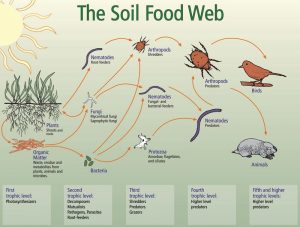Healthy soil, healthy plants, healthy people (by Bev Middleton)
Bev Middleton, from Macleod, is the Director of Healthy Soils Australia.
Healthy soil plays a key role in our food security, health, clean water, eco services and our climate.
Healthy soil has lots of organic matter, teeming with life
 Soil rich in microorganisms, fungi and nutrients produces nutrient dense food.
Soil rich in microorganisms, fungi and nutrients produces nutrient dense food.
While we cannot see them, microorganisms (aka microbes), protozoa and nematodes all provide the plants with the nutrients that they need plus protection against pests and disease.
Soil with lots of organic matter also has a good structure that holds more water and nutrients for the microorganisms in the soil.
Plants and the life in the soil have an arrangement to look after each other. As you know, plants use sunlight, CO2 and water and convert it to energy to grow (photosynthesis). As you may not know, they also send around 40% of the created sugars down their roots to feed the microorganisms and fungi in the soil. In return, the microorganisms and fungi provide the plant with the nutrients that they need plus they also protect the plant from pests and disease.
Build your own healthy soil
To improve your soil, add lots of organic matter and compost.
Five more principles to building soil health:
- Limit disturbance: digging and turning over soil harms the structure of the soil and destroys mycorrhizal fungi which are so important to plants and the soil food web.
- Keep your ground covered: bare ground heats up quickly, cooking the life in your soil. Less plants also means less photosynthesis and thus less food going down the roots to feed the life in the soil. Bare ground also attracts weeds.
- Diversity of plants encourages diversity of the life in your soil – they all have different preferences and less chance of dominance of bad guys.
- Keep living roots in the soil: living roots in the soil keep soil structure for the life in the soil to move around.
- Limit use of chemical pesticides, fungicides, and herbicides: these chemicals kill more than the targeted pests and diseases.
Compost methods
Food waste is best composted in rotating bins, buried or using a bokashi style system to minimise visiting rodents. Choose a method that suits your situation.
Most compost recipes fall into the camps of either ‘hot’ or ‘cool’ composting. Hot composting is quicker but requires turning two or three times each time that the pile reaches 65degC. Cool composting takes longer and must be turned to keep it aerobic.
Some tips for achieving good compost:
- Keep it aerobic. Anaerobic compost breeds non-beneficial microorganisms and smells really bad.
- Turn your compost frequently to ensure that it stays aerobic.
- Choose a recipe to suit your conditions, ensuring enough woody and brown materials in the mix (carbon to nitrogen ratio).
- To kill weed seeds, aim for all areas of your compost to reach a temperature of 55-60degC.
- Keep your compost moist, above 50% moisture.
For more information on the importance and benefits of healthy soil, visit the website of Soil Week Australia plus their Facebook and Instagram pages.
 Some fun facts
Some fun facts
- Soil is the most biodiverse ecosystem on the planet. Just one teaspoon of top soil can contain up to 6 billion microorganisms.
- About 25% of healthy soil is air – and it ‘breathes’, constantly exchanging gases with the atmosphere. The rate of this breathing, or respiration, is in fact one indicator of the microbial activity in, and therefore the health of, the soil.
- Most of the antibiotics that we use to fight illness originated from soil microbes, which employ them as weapons in the competition for resources and survival. Penicillin, the first successful antibiotic, came from the soil fungus Penicillium.
- Humans are way faster at making soil than nature. If we had to leave it up to nature to make up soil at the rate it is eroding, we’d be in a pickle because it can take up to 1,000 years to form 1cm of topsoil! Thankfully, humans can also make our own soil (hello compost) and restore degraded soil through better land management and farming practices. There are already farmers doing this and building the resilience of their land and their production.
- Most of the antibiotics that we use to fight illness originated from soil microbes, which employ them as weapons in the competition for resources and survival. Penicillin, the first successful antibiotic, came from the soil fungus Penicillium.
- ‘Top soil’ is the outermost layer of soil. It’s where most of those 6-billion-per-teaspoon organisms hang out and it’s where we grow 95% of our food. So top soil is a big deal but, at about 25cm deep on average, it is also disconcertingly thin.
- Healthy soils help protect the planet from climate change. According to Columbia University’s Earth Institute, “soils remove about 25% of the world’s fossil fuel emissions each year.” There is also the potential to remove more CO2 by changing agricultural practices to build healthy soil that stores carbon deep down in the soil.
- A 1% increase in soil organic carbon increases the capacity of soil to hold water by about 2%. This can equate to hundreds of thousands of litres per hectare, and can make a big difference to farmers’ yields and their ability to survive during extreme drought.

Thank you for your informative article.
I particularly enjoyed the points on aerobic and anaerobic composting.
My husband and I are trying to establish a community garden in Research-one of the concerns from a resident is rodents-namely rats attracting snakes-good to have local published data to help quell fears.